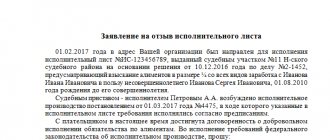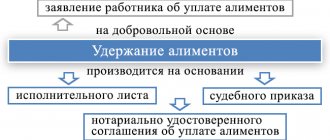8
A stable and trusting relationship between spouses after a divorce or maintaining contact between the parents of a common illegitimate child is rare. In such rare cases, the parent living separately from the child (most often the father) often wants to pay child support voluntarily, which the recipient of the support is usually very happy about.
But it so happens that if the spouses have already separated once for various reasons, then no one guarantees them the absence of conflicts in the future, for example, when the child’s mother wants to increase the amount of alimony or the child’s father accumulates debt for reasons beyond his control.
That is why it is important to formalize the procedure for voluntary payment of alimony in strict accordance with the rules of the law and established practice.
When can child support be transferred to a child’s account?
Transfer of funds to the personal bank account of a minor is possible under a child support agreement, a court decision, or in a situation where the child is placed in an institution with full state support.
The need to transfer funds to the child’s individual bank account arises if the payer has doubts about the targeted spending of the money. For example, when a minor constantly needs new clothes, eats poorly, while the mother does not deny herself anything and there are suspicions that she spends the money on herself.
According to the law, alimony can only be spent on children. Recipients have the right to spend them on food, education, purchasing clothes and shoes and other expenses in the interests of minors.
If the alimony obligee is not confident in the good faith of the ex-wife, he can verbally demand a report from her, but she is not obliged to provide it. In this case, it is logical to agree to change the payment method or file a corresponding lawsuit in court.
Learn more about child support reports for the father.
Art. 60 of the RF IC gives a positive answer to the question about the possibility of transferring alimony payments to a bank account, but with some reservations:
- The amount of payments received into the account should not exceed 50% of the total amount of alimony. This is due to the fact that the child will be able to use the accumulated money only after his 18th birthday, while funds for his maintenance are constantly required.
- The remaining amount of the payment in the hands of the recipient should be enough for all the needs of the minor: food, education, purchase of clothing, etc. The main goal of alimony is to provide the child with a decent standard of living. Even if, according to rough estimates, before the age of 18, a substantial amount has accumulated in the account, sufficient to buy an apartment (for example), and before this time it will be in need, the court will refuse to satisfy the claim to change the method of payment.
- The account must be opened in the name of the minor. According to the law, the mother or other legal representative of a minor does not have the right to withdraw alimony funds from the account. An exception is emergency cases: a child’s serious illness or the need for expensive treatment. In such situations, when providing documentary evidence, you will be able to use the finances after receiving permission from the guardianship authorities. Detailed conditions are specified in the agreement with the bank.
Important! Accounts must be opened in the name of children to whom child support is paid. If they are registered in the name of the recipients (father or mother), such alimony payments are not recognized.
Need a lawyer
The voluntariness of transferring financial support to a child before reaching the age of majority requires proper registration with legal justification. Otherwise, the alimony payer may fall into the category of non-payers and have problems traveling abroad and driving a car. Proving timely and full payment of alimony will require time and money.
Contacting an experienced lawyer will save you from possible problems in the future. It is impossible to find all the information on the Internet yourself. Each case is individual and requires personal consideration. An employee of our law firm will provide advice free of charge, online - through a written question or in a chat.
Who has the right to initiate?
The RF IC states that a parent who is obligated to transfer money has the right to initiate a change in the method of paying money for the maintenance of minors.
In practice, recipients can also apply to the court for this - in both cases the conditions are the same:
- Those obligated to pay alimony want to pay alimony to a bank account when they are not sure of the intended use of funds by the recipients or want the child to have an impressive amount by the time he reaches adulthood, sufficient to purchase real estate or expensive education abroad.
- For recipients, transferring 50% of alimony is beneficial if families have a good income and do not need to pay full amounts, and also want their sons or daughters to have a large amount of money by the time they turn 18, which they can use at their discretion.
How to get a report on how child support is spent?
How to refuse child support?
How to pay child support correctly?
How to voluntarily pay alimony without subsequently having problems with the recipient? The payment of alimony on a voluntary basis is not regulated by law. But documentary evidence of fulfillment of parental responsibilities is required. Unrecorded transfer of money during a personal meeting, anonymous postal and bank transfers create a risk for the parent to turn into a willful defaulter.
A verbal agreement does not mean the absence of payment documents.
The alimony obligee must pay maintenance, adhering to the following rules:
- The transfer of money must be carried out simultaneously with receipt of the receipt. A properly executed document has legal force in the event of conflict situations.
- Mail and bank receipts must be marked “child support.”
A long payment period is a feature of alimony payments. During this period, life circumstances may change unfavorably for the payer and recipient of alimony. To avoid negative consequences, good faith and voluntariness must be confirmed.
Maximum amount of child support
Art. 60 of the RF IC regulates the maximum amount of alimony for transfer to a child’s bank account – 50% of the total amount. Smaller restrictions may be set, but larger ones may not.
Let's look at a practical example:
The alimony payer earns 70,000 rubles monthly, money is paid for the maintenance of one child - 25% of the salary (17,500 rubles). The man suspects that his ex-wife is spending money on herself because his son constantly needs new clothes, which he has to buy in addition to alimony payments.
The alimony obligee decides to change the method of payment on the basis of Art. 60 of the RF IC and submits an application to the court, citing the need of the child and suspicions of misappropriation of funds by the mother.
After studying the case materials, the court makes a positive decision on the claim. From this moment on, the woman receives 50% of the amount of 17,500 rubles, i.e. 8,750 rubles. An equal amount is transferred by the payer to the minor’s bank account.
What nuances were taken into account by the court when considering the issue:
- Father's salary. Compared to other payers, he transfers a higher amount. If a man earned 25,000-30,000 rubles, like most other alimony payers, the claim would most likely be denied. In this case, the child instead of 17,500 rubles. would receive no more than 7,500 rubles, and when divided by 50%, payments decreased to 3,750 rubles, which is not enough to ensure an optimal standard of living.
- The cost of living per child in the region. On average it is 8000-9000 rubles. depending on the subject of residence of the minor.
- Additional financial assistance provided by the payer. The man provided receipts for the purchase of clothing, confirming that, in addition to alimony, he partially provides for the child.
It is important to take into account that if, as a result of a change in the method of paying money for the maintenance of a minor, the amount of transfers is significantly lower than the subsistence level, the claim may be refused.
How to open an account for a child? Step-by-step algorithm
A bank account is opened before going to court with a claim to change the method of paying alimony.
To do this you need to do the following:
- Select a financial institution that suits the conditions.
- Submit an application form.
- Sign the agreement and fill out the card with sample signatures.
- Issue a receipt order and deposit funds into the account.
- Receive account documents.
A fee is charged for servicing a bank account. More detailed conditions are contained in the programs and agreements of financial institutions.
Documentation
When contacting the bank you are provided with:
- applicant's passport;
- TIN;
- child's birth certificate.
If the child is over 14 years old, you will need his passport.
Duration and frequency of alimony payments
The period for payment of alimony is until the child reaches the age of majority or the occurrence of another event that serves as the basis for termination of payments. We wrote about all this in detail in our other articles.
In case of voluntary payment under an oral contract or agreement, the parents themselves can agree on the frequency of payments and make them in a mode convenient for everyone - at least once a week, at least once a year.
If alimony is paid in accordance with the writ of execution sent to the place of work, payments will be made strictly monthly.
ATTENTION! You can ask experienced family lawyers on the Prav.io portal with any questions related to the assignment, payment, and withholding of alimony.
On the portal you can also find an experienced lawyer who lives in the same city as you and can provide real support during complex litigation regarding the collection of alimony.
Changing the method of paying alimony to open an account: step-by-step instructions
The procedure for transferring part of the alimony to the bank account of a minor is as follows:
- The plaintiff collects evidence on the basis of which the court must satisfy the claims. If the applicant is the payer, information about misuse of alimony will be needed. This may include witness statements, pay stubs, and receipts. When filing a claim, the recipient's initiative is sufficient.
- A statement of claim is drawn up and the state fee is paid. Details for paying the fee can be obtained on the official website of the court.
- The claim with documents is submitted to the judicial authority.
- Within 5 days, the judge decides to open proceedings.
- The parties are sent notices with the date of the first hearing.
- The plaintiff and defendant appear in court on the appointed day.
- Proceedings last up to 2 months. Based on the results, a writ of execution (WW) and a court decision are issued.
A writ of execution is issued after the court decision enters into legal force. The interested party visits the bailiffs with him. It is also possible to submit a writ of execution to the accounting department of the enterprise if payments are calculated by an accountant.
Where to contact?
To change the method of payment of alimony, a claim is filed with the judicial authority that made the original decision.
If the value of the claims does not exceed 50,000 rubles, the cases are considered by the magistrates' courts. In other cases - regional.
How to file a claim?
Claims in civil cases are drawn up in accordance with the rules of Art. 131 Code of Civil Procedure of the Russian Federation. There is no unified form.
The application must contain the following information:
- name of the judicial authority;
- Full name, date of birth, passport details, registered address of the plaintiff;
- Full name, residential address of the defendant;
- Full name, date of birth of the child, series and number of the child’s certificate;
- details of the previous court decision;
- method of payment of alimony - in shares, mixed or in a fixed amount;
- grounds for transferring part of payments to a bank account: suspicions of unreasonable spending by the recipient, etc.;
- claims: establish the possibility of transferring alimony indicating the exact amount to the child’s bank account, change the method and procedure for implementing the previous decision;
- date of compilation and signature.
If the plaintiff is an alimony recipient, the desire to form monetary savings for the minor, provided there is a sufficient level of income in the family, can be indicated as a justification for the demands.
The application is submitted in two copies. One court secretary accepts the case, the second one is marked with registration - the plaintiff may need it when filing claims against the judicial authority in case of untimely consideration of the documentation.
Documentation
At your first visit to court you will be provided with:
- passport;
- previous court decision;
- child's birth certificate (if possible);
- bank account details.
State duty
Recipients, when filing claims for alimony, are exempt from paying state duty - it is collected from those obligated for alimony in the amount of 150 rubles. for each child.
If the plaintiff is the payer, the fee is paid by him before filing the claim.
Application for voluntary payment (sample)
The application for voluntary payment of alimony (sample) does not have an approved form. It cannot be submitted by the payer. The need for such a document arises when the recipient revokes the writ of execution. Reason: an agreement reached with the ex-spouse on the voluntary transfer of an amount less or more than that required by a writ of execution or a notarial document.
The application is submitted to the head of the Federal Bailiff Service at the place where the writ of execution was filed.
The document must contain the necessary information:
- name and location of the bailiff service;
- personal data of the applicant;
- address data;
- information about the writ of execution or notarial agreement;
- reason for revocation of the writ of execution;
- request for a refund;
- day month Year;
- signature.
A sample application for revocation of a writ of execution can be downloaded here
The document header contains the following data:
- to the head of the FSPP;
- organization address;
- surname, name, patronymic of the applicant;
- place of registration;
- whose interests are represented.
Title: “Application for termination of the writ of execution (notarial agreement) for the payment of alimony.”
The content of the document has 4 logically related parts.
Part one. It is indicated when (date), what document (number, date), on the basis of what decision (date number), its essence, in whose favor it was sent.
Part two. Fulfillment of orders, executor.
Part three. Reason for withdrawal (agreed upon).
Part four. Please return the writ of execution in person.
Signature (with transcript), day, month, year.
Drafting a document can be challenging.
Alimony to the child's bank account by agreement
An alimony agreement is the best option for spouses or former spouses who have no disagreements regarding the transfer of funds to a minor. If the recipient agrees, the parties can formalize the agreement with a notary.
Information specified in the agreement:
- Full name, passport details, registration addresses of the parties;
- Full name, series and number of the child’s birth certificate;
- the main part is the transfer of a share of alimony to the minor’s personal bank account;
- date of registration and signature.
The agreement is subject to mandatory notarization and is an executive document (ID). It is drawn up in 3 copies and handed over to each party.
When collecting alimony through bailiffs, the agreement is submitted to the FSSP. If money is paid through the accounting department at the payer’s place of employment, the document is presented there.
After presenting the agreement, deductions are made according to the conditions established by it by the accountant - part goes to the recipient, the rest goes to the minor’s bank account.
Is it possible to voluntarily pay child support?
The parent is obligated to pay child support, and has the right to do so on a voluntary basis. This requires a compromise solution with the recipient of the salary. This can be achieved in the following cases:
- By verbal agreement, with mutual consent, the parents decide how much, when, in what form and where cash will be transferred.
- To consolidate contractual relations, former spouses turn to a notary. The agreement is drawn up in free form, indicating the necessary information, and certified by a notary. The document will be required if there are delays in the transfer of funds or unfounded claims on the part of the recipient.
- After a court decision to collect the debt, the defendant can agree on the voluntary payment of alimony in the required amount, without involving the SSP.
Voluntary transfer of financial support to a child cannot be accompanied by infringement of his legal rights. The father and mother do not have the right to agree on financial support below that established by law. In these cases, the guardianship authorities are obliged to intervene and demand payments in full. They have the right to challenge such a decision in court.
Arbitrage practice
At the moment, judicial practice under Art. 60 RF IC is not rich in cases. Many people prefer to transfer money in the usual way - to the recipient personally. An analysis of completed cases shows that, if there are grounds, the courts satisfy the claims of payers to transfer part of the alimony to bank accounts.
If the initiator is recipients who have high incomes and the ability to fully provide for children, a positive decision on the claim can be obtained with a high probability.
However, fathers often go to court without sufficient grounds. The amount of alimony paid does not matter if it is all spent on the needs of the child.
For example, a minor participates in international dance competitions. It is necessary to pay for flights, costumes, and rehearsals. Or the child goes in for horseback riding.
Thus, in order for the court to satisfy the requirements for the transfer of funds to the child’s account at least partially, the following requirements must be met:
- the payer monthly transfers a large amount for the maintenance of a minor (at least 2 subsistence minimums);
- he has evidence of misuse of funds (photos, videos, witness statements).
As practice shows, it is quite difficult to prove abuse of a mother.
How to transfer money to an account?
To transfer money to a minor’s bank account, it is enough to have his details at hand - they are indicated in the court decision and IL.
The procedure is carried out as follows:
- A few days before the mandatory payment date, the payer transfers the funds. This can be done online or through the bank's operating office. The purpose of payment indicates: “child support (full name). When transferring through your personal account, this phrase is written in the comments. This is necessary so that the ex-wife cannot collect payments again - the payer will be able to prove the conscientious fulfillment of obligations.
- It is recommended that you save the received transaction receipt.
Important! The term for transferring money depends on the specific bank, varies from 1 to 3 days, so it is recommended to make payments in advance. For each day of delay you will have to pay 0.1% of the total amount as a penalty.
Lawyer's answers to questions about transferring alimony to a child's account
What are the chances of the claim being approved?
Here everything depends on the evidence presented by the plaintiff-payer. If he presents to the court photographs from his ex-wife’s vacation spots, receipts for the purchase of expensive clothes, this will only indirectly indicate inappropriate spending, but cannot be used as evidence.
Is it possible to distribute funds without a court decision?
Yes, if there is a child support agreement. In other cases, if desired, the ex-wife will be able to re-collect alimony for the past 3 years or for the entire period, if an IP was initiated.
Is it possible to transfer money to a child’s savings book?
Transferring funds to a minor's savings book is possible in any case: if he lives with his mother, guardians, or in a government institution. The standard algorithm for changing the payment method is used here.
Is it possible to transfer alimony to a bank account if the child’s mother refuses the money and there is no court decision or agreement?
In the absence of assigned alimony obligations, a man will not be able to file a claim against himself - this can only be done by his ex-wife, with whom the minor remains. In such a situation, it is recommended to save money into your bank account so that in the future, if the woman decides to collect alimony for the past period (3 years), she can quickly transfer it.







